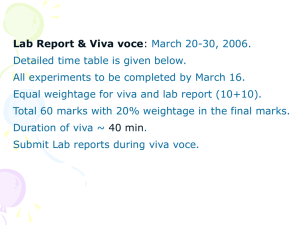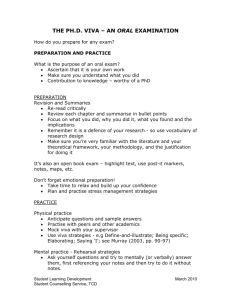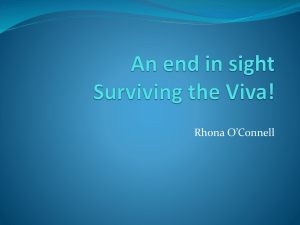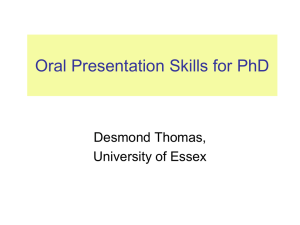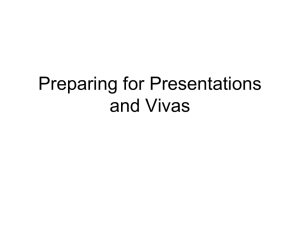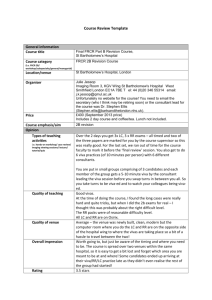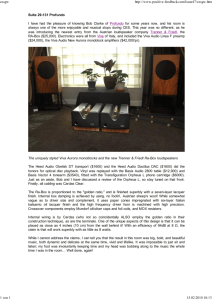Sam Heaton
advertisement
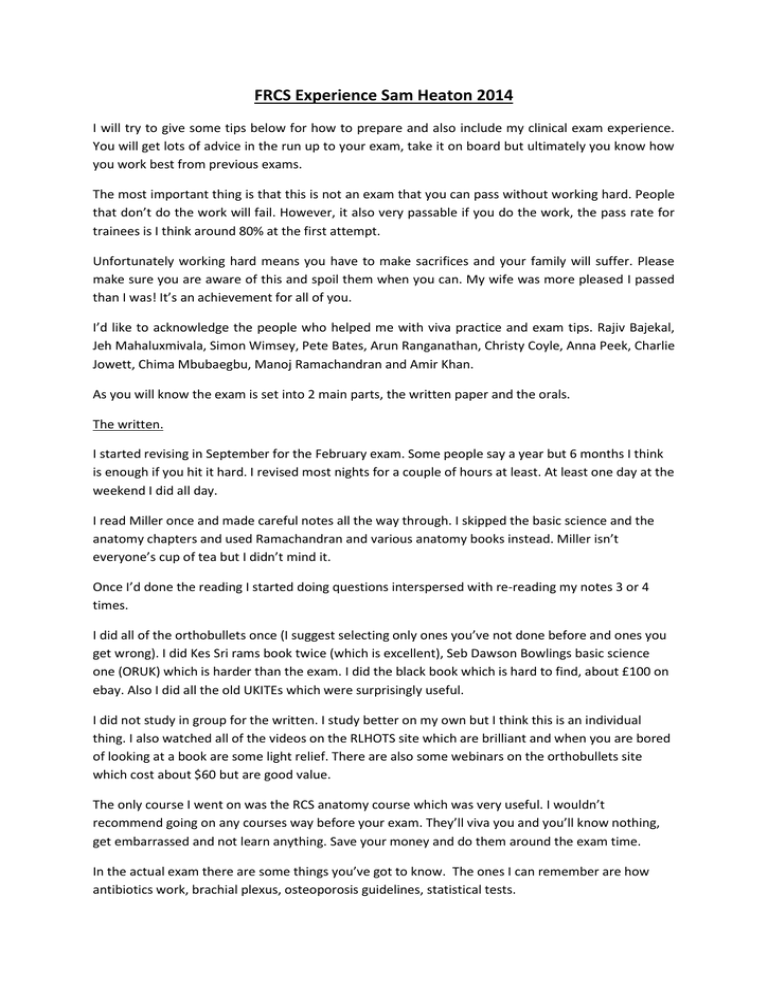
FRCS Experience Sam Heaton 2014 I will try to give some tips below for how to prepare and also include my clinical exam experience. You will get lots of advice in the run up to your exam, take it on board but ultimately you know how you work best from previous exams. The most important thing is that this is not an exam that you can pass without working hard. People that don’t do the work will fail. However, it also very passable if you do the work, the pass rate for trainees is I think around 80% at the first attempt. Unfortunately working hard means you have to make sacrifices and your family will suffer. Please make sure you are aware of this and spoil them when you can. My wife was more pleased I passed than I was! It’s an achievement for all of you. I’d like to acknowledge the people who helped me with viva practice and exam tips. Rajiv Bajekal, Jeh Mahaluxmivala, Simon Wimsey, Pete Bates, Arun Ranganathan, Christy Coyle, Anna Peek, Charlie Jowett, Chima Mbubaegbu, Manoj Ramachandran and Amir Khan. As you will know the exam is set into 2 main parts, the written paper and the orals. The written. I started revising in September for the February exam. Some people say a year but 6 months I think is enough if you hit it hard. I revised most nights for a couple of hours at least. At least one day at the weekend I did all day. I read Miller once and made careful notes all the way through. I skipped the basic science and the anatomy chapters and used Ramachandran and various anatomy books instead. Miller isn’t everyone’s cup of tea but I didn’t mind it. Once I’d done the reading I started doing questions interspersed with re-reading my notes 3 or 4 times. I did all of the orthobullets once (I suggest selecting only ones you’ve not done before and ones you get wrong). I did Kes Sri rams book twice (which is excellent), Seb Dawson Bowlings basic science one (ORUK) which is harder than the exam. I did the black book which is hard to find, about £100 on ebay. Also I did all the old UKITEs which were surprisingly useful. I did not study in group for the written. I study better on my own but I think this is an individual thing. I also watched all of the videos on the RLHOTS site which are brilliant and when you are bored of looking at a book are some light relief. There are also some webinars on the orthobullets site which cost about $60 but are good value. The only course I went on was the RCS anatomy course which was very useful. I wouldn’t recommend going on any courses way before your exam. They’ll viva you and you’ll know nothing, get embarrassed and not learn anything. Save your money and do them around the exam time. In the actual exam there are some things you’ve got to know. The ones I can remember are how antibiotics work, brachial plexus, osteoporosis guidelines, statistical tests. Before the exam make sure you’ve had a good nights sleep. You’ll need to be rested The Orals I only had 2 months between this and the written but it was enough. Do the orals as soon as you can because the theoretical knowledge is there and you’ll soon forget it. I did loads of courses and all were useful. I did so many as I didn’t have study buddy originally and felt I needed the practice. However, I found 2 Stanmore guys at a course and we practised together. It is essential to have a study buddy. I felt I didn’t know how to slickly exam people and we practised our examinations again and again until we could do them with our eyes shut. We met every other night and most weekends in a # clinic to practise. Also went to a couple of hand lists to see some dupytrens and RA hands. The courses I did qre below and were all worth it. Norwich was particularly good. Cardiff spine viva Cardiff general viva Cardiff papers Swansea hand RLHOTS trauma Cambridge basic science Norwich viva I also had some viva practise with consultants and with SpRs who had all recently passed. Don’t be shy with asking, people were usually very flattered to be asked and were keen to help. Also sit at the front in the trauma meeting and ask to be grilled. It really helps. I also read the Banaskewicz viva book twice which was good. www.frcsorthnorth also has the northern deaneries exam experiences and was a great help. Everyone goes on about learning papers. I learnt about 15 and only really knew the conclusions the names, the year and the journal. I practised my drawings. Cross sectional anatomy, clotting cascade, collagen, physis, cartilage etc etc. I actually drew a cross section of the foot in the exam and showed all the layers and how I’d decompress the compartments, the examiner was loving it! The exam itself was pretty scary but was actually quiet fun in the end and very fair. The examiners were all nice, no one was trying to catch me out. It is in 2 sections. All marks are from 4-8. 4 being a bad fail, 6 being a pass and 8 being amazeballs. You need an average of 6 to pass. There are about 60 odd times you’ll be scored so plenty of opportunity. 1. Clinical a. 2 intermediate cases of 15 mins. 1 upper and 1 lower limb. 5 mins for history, 5 for examination and 5 for question. b. 3 upper limb 5 minutes cases and 3 lower limb 5 minute cases 2. Viva. 4 stations done 1 or 2 days after the clinical. 30 inute stations with 2 examiners. They each have 15 minutes and will try to ask you 3 questions each. a. Basic science b. Trauma c. Adult Path d. Paeds and Hands My cases Clinical Upper limb 1. Asked to “exam this woman’s right shoulder”. Went through the normal look feel move. She had arthroscopy scars on both sides and what looked like an open ACJ excision scar (possibly open cuff). Her cuff worked but was a bit weak so that’s what I said. Examiner said “you’ve mentioned the ACJ, does the clavicle have any other joints?” So I looked at the SCJ which was massive. Could have been anterior dislocation (old), OA or tumour/infection. We talked about anterior dislocation of SCJ for 30 seconds (get cardiothoracics involved, use a towel clip etc) then the bell went. 2. Next was “examine the nerves in this man’s hands. He had a CTD scar about 6 weeks old and not much else. I went through my nerve exams but it wasn’t straight forward as he had mixed signs with some bits working and some bits not working in each nerve. There was no paper to do froment’s test so one examiner left halfway through to get some! I never really came to a conclusion and mumbled something about median and ulnar nerve mixed picture, maybe the CTD had released both and they were recovering. The examiner wasn’t impressed, then the bell went. 3. Finally had a muscly middle aged guy with a biceps tendon rupture. Easy spot diagnosis and talked about treatment, approach, forgot to mention to look out for PIN in the approach but was prompted and got there in the end. Lower Limb 1. A person of short stature in a wheelchair. Was told I could ask one question so said “what is your diagnosis”. Patient and examiners all laughed and said I couldn’t ask that, so I asked why she was under orthopaedics and she said “because my bones keep breaking”. Boom OI!! Asked about teeth, (forgot to ask if deaf – patient was lovely and kept pointing at her ears to help me – I thought she was mad then realised after!). Didn’t get her out of the wheelchair but had a quick look at her back (scoli) and her legs. Talked about Sillence classification. 2. Horrible case. Old woman with scarred multiply operated feet. Could have been pes cavus, old CTEV. The exam area was small and dark and I really couldn’t see anything. I went through my foot exam. I think she’d had some fusions but I basically totally messed this one up. 3. Woman in her 40s with knee pain. She pointed to lateral knee. Nil on exam but she then said she had a popping feeling over her proximal tib/fib joint so I said she had a subluxing joint here (I’d never heard of this but the examiner said I was right and that he’d never heard of it either). I did a Beighton score and checked the CPN which they liked. Said I’d do nothing for her. Intermediate 1. Upper limb. This was a woman with upper thoracic back pain. Aged 45 ish. History was long term, did my standard medical school clerking. Then examined and she had a tight curve and lots of café au lait spots. Clearly NF so looked for Lisch nodules, axillary freckling etc. Asked for an XRay and MRI. Said I’d manage non –op and then we talked about NF for 5 minutes. That sounds hard but once you’ve revised it you’ll be loving the chance to spout all the rubbish you’ve learnt. 2. Lower limb. Post op THR take a history. She was a revision for failed BHR, Turns out when she woke up she couldn’t move her leg much. On examination she had femoral nerve palsy. Was asked how this happened, I said likely retractors as they’d gone posterior. He showed me the MRI where the trial head was sitting in the pelvis pushing on the lumbosacral plexus! Talked about anatomy for a bit. Overall I was upset after the clinicals. I felt the short cases had gone really badly but you must remember to pick yourself up and put it behind you because there are so many other opportunities to score to compensate. Vivas. I was most scared about this out of all the exams. There really is nowhere to hide. Actually I really enjoyed it and masochistically wouldn’t mind doing it again as by that stage you know more general ortho than you will ever know. Basic Science TKR loosening with bone loss. Why has it happened? Osteolysis, bone graft, augments. Osteogenesis Imperfecta again – boom! Deltopectoral approach. Once I got going on this (I’d practiced my chat on all the approaches) they soon stopped me and asked difficult related stuff (how many cms below the coracoid is the Muscolucutaneous nerve etc!) Wear The course of the sciatic nerve Knee OCD in an athlete. Draw cartilage. Talk about microfracture (how to do it, what instruments, what size pick etc), ACI/MACI. He ran out of questions and we started talking about football (the exam was in the Southampton stadium) and the average age of retirement of an outfield player versus a goalie!! Paeds and Hands Enchondroma in a distal phalanx Bony mallet Lump on wrist (it was massive, I think it was tenosynovitis so we talked about that for a bit) DDH Kid with varus knees – draw selenius curve Lateral humeral condyle, Milch type injury Trauma Open fracture in an old lady from a simple trip. Bimalleolar with extensive pretibial degloving. Talked about BOA/BAPRAS guidelines, ex fix, hind foot nail, plastics. Galeazzi fracture, how to fix and the approach Lis Franc and how to fix, foot compartment syndrome. Supracondylar in a kid. Proximal humerus fracture in an old lady, talked about Hertel lego bricks, they liked that. 1 column wedge fracture, for simple conservative management, I thought I must be missing something but I wasn’t! Adult path AVN of hip in young guy, Classify, causes, treatment. They asked what hip I would use. I had practised to say cemented Exeter for everything but for some reason blurted out Corail Pinnacle but managed to rescue it with a good explanation. Massive cuff tear in old lady. Principles of reverse shoulder Rheumatoid elbow and the treatments. Conrad morrey. Periprosthetic hip fracture, loose Loose painful THR, how to work up, what to do. 2 stage versus 1 stage Can’t remember the last one All in all a very fair exam. It will take over your life when you do it, remember to be nice to your family, revise hard for the written and practice hard for the orals. Call me if you want viva practice. Adios and good luck Sam
